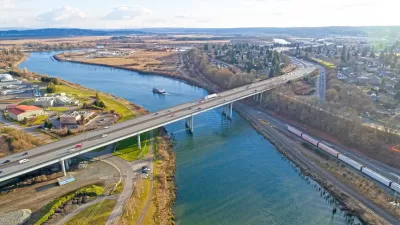Around the world, countries are building new dams for hydroelectric power at a frenzied pace. Vox examines the benefits and drawbacks of hydroelectric power.
Brad Plumer reports news of a study published in Aquatic Studies finding that, in addition to facilities that already produce 16 percent of the world's electricity, "an additional 3,700 large hydroelectric dams are either under construction or being planned worldwide, largely in Latin America and Asia."
"All told, global hydropower production is on pace to double in the next two decades to 1,700 gigawatts, predict the study's authors, from the University ofTübingen in Germany. That would reduce the number of large free-flowing rivers on the planet by another 20 percent."
Plumer then goes on to examine the complex politics and economics of hydropower, including the desperate need for electricity in many developing countries and the surprising impacts of dams once they're built. On that latter point, the "Aquatic Sciences paper, by providing a comprehensive database of the 3,700 largest dams under construction, is hoping to help planners address some of these concerns. 'Clearly,' the authors note, "there is an urgent need to evaluate and to mitigate the social, economic, and ecological ramifications of the current boom in global dam construction."
FULL STORY: We're damming up every last big river on Earth. Is that really a good idea?

Planetizen Federal Action Tracker
A weekly monitor of how Trump’s orders and actions are impacting planners and planning in America.

Restaurant Patios Were a Pandemic Win — Why Were They so Hard to Keep?
Social distancing requirements and changes in travel patterns prompted cities to pilot new uses for street and sidewalk space. Then it got complicated.

Map: Where Senate Republicans Want to Sell Your Public Lands
For public land advocates, the Senate Republicans’ proposal to sell millions of acres of public land in the West is “the biggest fight of their careers.”

Maui's Vacation Rental Debate Turns Ugly
Verbal attacks, misinformation campaigns and fistfights plague a high-stakes debate to convert thousands of vacation rentals into long-term housing.

San Francisco Suspends Traffic Calming Amidst Record Deaths
Citing “a challenging fiscal landscape,” the city will cease the program on the heels of 42 traffic deaths, including 24 pedestrians.

California Homeless Arrests, Citations Spike After Ruling
An investigation reveals that anti-homeless actions increased up to 500% after Grants Pass v. Johnson — even in cities claiming no policy change.
Urban Design for Planners 1: Software Tools
This six-course series explores essential urban design concepts using open source software and equips planners with the tools they need to participate fully in the urban design process.
Planning for Universal Design
Learn the tools for implementing Universal Design in planning regulations.
Heyer Gruel & Associates PA
JM Goldson LLC
Custer County Colorado
City of Camden Redevelopment Agency
City of Astoria
Transportation Research & Education Center (TREC) at Portland State University
Camden Redevelopment Agency
City of Claremont
Municipality of Princeton (NJ)





























